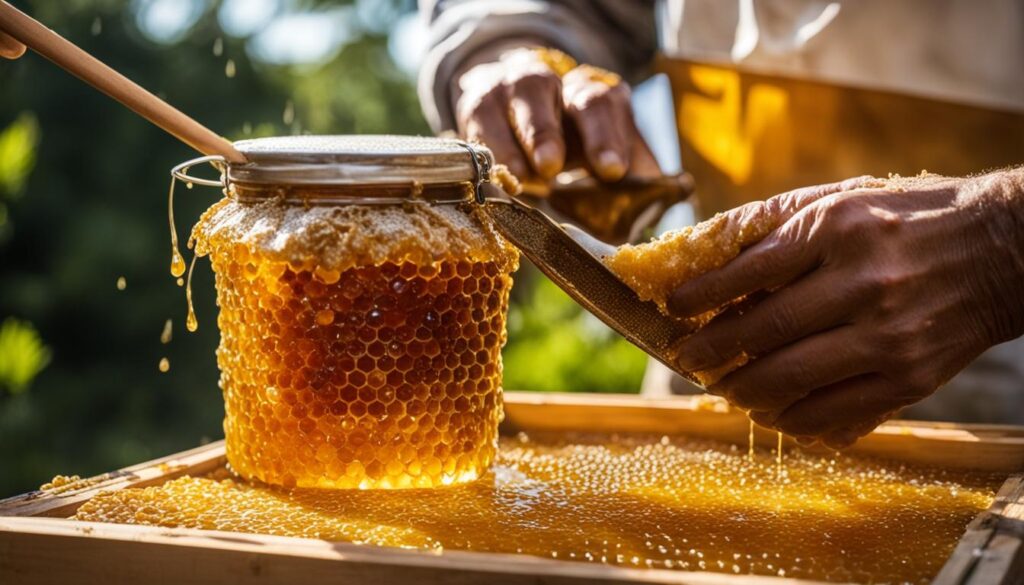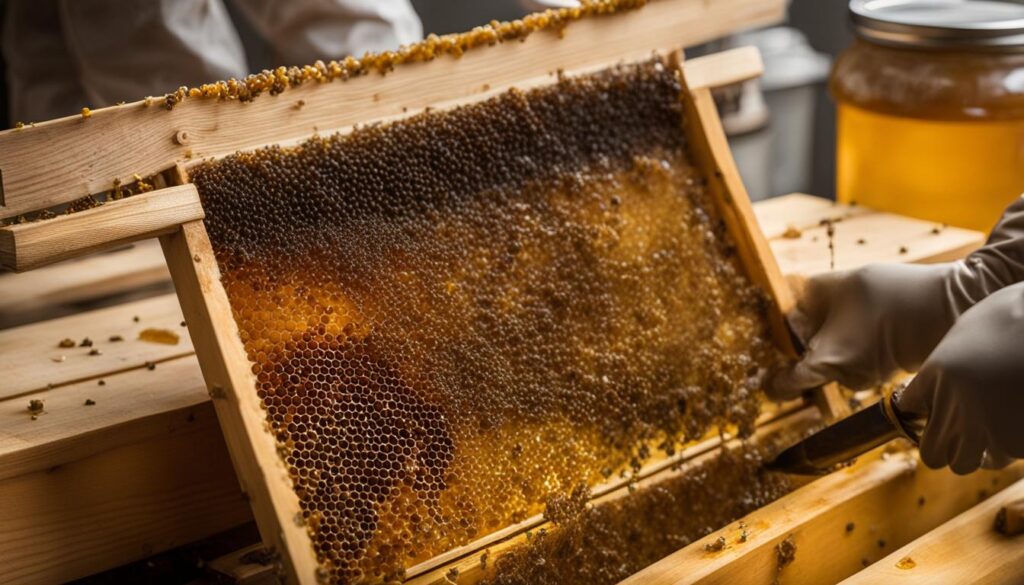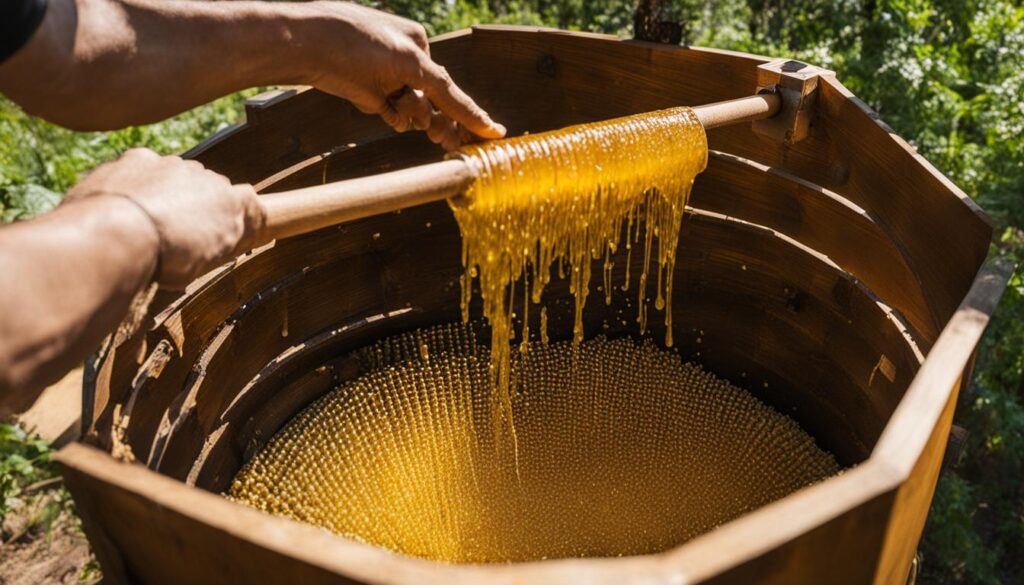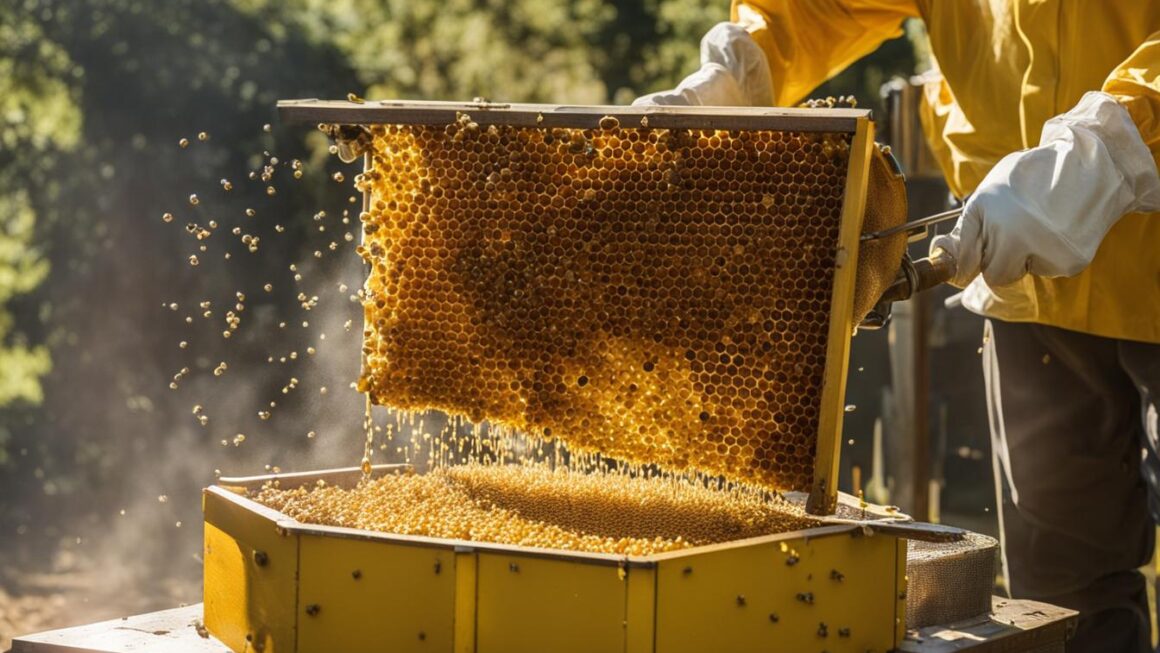Honey extraction is a fundamental skill that every beekeeper should master. It allows beekeepers to reap the sweet rewards of their hard work and provides a way to share the delicious honey with others. In this article, we will explore the honey extraction process, different techniques, and essential tools for successful honey harvesting.
Key Takeaways:
- Honey extraction is an essential skill for beekeepers to enjoy the fruits of their labor.
- Beekeepers should ensure that their colonies have enough honey for winter before harvesting.
- The honey extraction process can be done using a honey extractor or the crush and strain method.
- Proper storage is crucial to prevent spoilage and crystallization of extracted honey.
- Beekeepers can explore various hive products beyond honey, such as beeswax and pollen.
The Honey-Making Process
The process of honey-making begins with bees collecting nectar from flowers using their proboscis. This nectar is then stored in their honey stomach, where enzymes are added to it. Back at the hive, the bees regurgitate the nectar into cells in the honeycomb where it undergoes dehydration. Both active and passive dehydration methods are used by the bees to remove excess moisture from the nectar, transforming it into honey. Once the honey is ready, the honeycomb cells are capped with wax to seal it.
Several methods and equipment can be used for honey extraction. Beekeepers can choose to use a honey extractor or the crush and strain method. A honey extractor is a machine that uses centrifugal force to separate the honey from the beeswax comb. This method preserves the structural integrity of the comb and allows beekeepers to return empty honeycombs to the bees. On the other hand, the crush and strain method is a simpler option that involves crushing the comb and straining the liquid honey to separate it from the wax. Both methods can be effective for honey extraction, and the choice depends on the beekeeper’s preferences and resources.
It is fascinating to observe the intricate process of honey-making and to understand the various methods and equipment involved in honey extraction. Whether using a honey extractor or the crush and strain method, beekeepers play a vital role in harvesting the sweet rewards of their bees’ hard work.
The Honey-Making Process
| Step | Description |
|---|---|
| 1 | Bees collect nectar from flowers using their proboscis |
| 2 | Nectar is stored in the honey stomach, where enzymes are added |
| 3 | Bees regurgitate nectar into cells in the honeycomb for dehydration |
| 4 | Active and passive dehydration methods remove excess moisture from the nectar |
| 5 | Honeycomb cells are capped with wax to seal the honey |
Harvesting Honey with the Crush and Strain Method
The crush and strain method is a popular choice for many hobbyist beekeepers, as it allows them to extract honey using everyday kitchen items. This method is simple and does not require specialized equipment like honey extractors. Instead, it relies on basic tools that are readily available in most kitchens. To begin the process, beekeepers need to gather the following essential equipment:
- Honeycomb
- Large pots or food-grade plastic buckets
- A potato masher or wooden spoon
- A kitchen sieve
- Cheesecloth
- A long serrated knife
Once the necessary equipment is ready, beekeepers can start the extraction process. They begin by crushing the honeycomb in a bucket or pot to release the honey. This can be done using a potato masher or a wooden spoon. The crushed comb is then strained through a kitchen sieve lined with cheesecloth to separate the liquid honey from the solid wax and other debris. The filtered honey is collected in a clean container, where it should be allowed to settle for a couple of days to ensure any air bubbles rise to the surface.
After the settling period, beekeepers can transfer the honey into jars, making sure to leave some space at the top for expansion. It is important to note that honey harvested using the crush and strain method may differ in appearance from honey extracted using a honey extractor. The crush and strain method often results in a cloudy honey with more impurities. However, the taste and quality of the honey remain intact.
Comparison: Honey Extractor vs. Crush and Strain Method
| Honey Extractor | Crush and Strain Method | |
|---|---|---|
| Equipment | Specialized honey extractor | Basic kitchen tools |
| Efficiency | Extracts honey from multiple frames at once | Can only process one frame at a time |
| Appearance | Clear honey with minimal impurities | Cloudy honey with more impurities |
| Cost | Higher initial investment | Lower cost, as no specialized equipment is needed |
| Difficulty | Requires some skill and experience | Suitable for beginners and hobbyist beekeepers |
Both methods offer their own advantages and are suitable for different beekeeping operations. Hobbyist beekeepers who have a small number of hives may find the crush and strain method more convenient and cost-effective, while commercial beekeepers with larger apiaries may prefer the efficiency of a honey extractor. Ultimately, the choice between the two methods depends on the beekeeper’s needs, resources, and personal preference.

Honey Extraction Tools and Techniques
Beekeepers have a range of tools and techniques at their disposal for honey extraction. The exact tools needed depend on the beekeeper’s apiary size and preferences. Essential tools include protective beekeeper clothing, a hive tool, a beekeeper’s smoker (although not used during honey extraction), and a way to transport the honey supers to a secure location. The honey extraction process involves removing honey supers from the hives, processing the honey crop using an extractor or the crush and strain method, and storing the honey in clean and safe containers. Proper equipment and techniques ensure a successful honey extraction.
Honey Extraction Equipment
When it comes to honey extraction equipment, beekeepers have several options. One popular choice is the honey extractor, a machine that uses centrifugal force to extract honey from the beeswax comb. Honey extractors come in both electric and manual versions, providing flexibility for beekeepers with different needs and preferences. Another method is the crush and strain technique, which requires basic kitchen equipment such as a large pot, a potato masher or wooden spoon, a sieve, and cheesecloth. This method is favored by hobbyist beekeepers as it allows them to extract honey using everyday items.
Techniques for Successful Honey Extraction
Successful honey extraction relies on proper techniques. Beekeepers should start by removing the honey supers from the hives, ensuring that they are free from bees. The supers can then be transported to a secure location for processing. Depending on the chosen method, beekeepers can use a honey extractor to spin out the honey or crush and strain the comb to separate the honey manually. The extracted honey should be strained to remove any impurities before it is stored in clean containers. These techniques, when executed correctly, help produce high-quality honey for beekeepers to enjoy and share.
Table: Essential Honey Extraction Tools
| Tool | Description |
|---|---|
| Protective Beekeeper Clothing | Includes a beekeeper suit, gloves, and a veil to provide protection against bee stings. |
| Hive Tool | Used to pry open hive boxes, remove frames, and scrape excess propolis. |
| Beekeeper’s Smoker | Used during hive inspections to calm the bees and minimize stinging. |
| Honey Supers Transport | Equipment such as a cart or wagon to safely move honey supers from the hives to a processing area. |
The Role of Honey Extractors
When it comes to honey extraction, honey extractors play a vital role in simplifying the process for beekeepers. These machines use centrifugal force to extract liquid honey from the beeswax comb, separating the honey from the wax. Honey extractors are available in both electric and manual options, allowing beekeepers to choose the one that best suits their needs and preferences.
One of the key advantages of using a honey extractor is the ability to give empty honeycombs back to the bees. This helps bees save valuable time and energy that would otherwise be spent rebuilding the comb. Additionally, using a honey extractor preserves the structural integrity of the comb, allowing it to be reused for future honey production.
While honey extractors are highly effective in extracting honey, it’s important to note that the crush and strain method is also a viable option, particularly for beekeepers with a smaller number of hives. The crush and strain method involves manually crushing the comb and straining the liquid honey, making it a cost-effective alternative to honey extractors.
“Honey extractors simplify the honey extraction process, allowing beekeepers to efficiently separate honey from beeswax. Whether using a honey extractor or the crush and strain method, beekeepers can enjoy the rewards of their hard work in producing delicious honey.”
| Advantages of Honey Extractors | Advantages of Crush and Strain Method |
|---|---|
|
|
Ultimately, whether beekeepers choose to use a honey extractor or the crush and strain method, the goal remains the same – to extract the sweet rewards of their beekeeping efforts. Both techniques have their advantages, and beekeepers can choose the method that aligns best with their apiary size, equipment availability, and personal preferences.
Cleaning and Storing Extracted Honey
Once honey has been extracted from the beehives, it is important to clean and store it properly to maintain its quality and longevity. Cleaning the extracted honey involves removing any impurities that may have been collected during the extraction process. The honey should be filtered using a mesh strainer to remove bits of comb, debris, or any other foreign particles.

After the honey has been filtered, it can be bottled and stored in clean containers. It is important to use containers specifically designed for food storage, such as glass jars or food-grade plastic containers. Proper labeling of the containers is also essential, ensuring information about the origin, date of extraction, and any other relevant details are provided.
Honey should be stored in a cool and dry place, away from direct sunlight and excessive heat. Exposure to heat and light can cause the honey to deteriorate and lose its quality. It is normal for honey to crystallize over time, but this process can be reversed by gently heating the honey in a warm water bath. Avoid overheating the honey, as this can cause it to lose its nutritional properties.
Hive Products Beyond Honey
While honey is undoubtedly the star of the show when it comes to beekeeping, beehives offer a treasure trove of other valuable products. One such product is beeswax, a versatile material that beekeepers can collect and utilize in various ways. Beeswax is known for its natural moisturizing properties, making it a key ingredient in candles, lip balms, ointments, and lotions. By collecting and repurposing beeswax, beekeepers can not only maximize the resources from their hives but also create additional revenue streams.
“Beeswax is a remarkable substance that has been used by humans for centuries for its multitude of applications. From skincare products to crafting, its versatility and natural properties make it highly sought after.”
In addition to beeswax, beekeepers can also harvest royal jelly and pollen from their hives. Royal jelly, secreted by worker bees, is a nutrient-rich substance that has gained attention for its potential health benefits. Some people use royal jelly as a dietary supplement, believing it to have various medicinal properties. Pollen, on the other hand, is rich in protein and can be collected from hives and added to foods such as smoothies and granola for an extra nutritional boost.
Lastly, another hive product worth mentioning is mead, an alcoholic beverage made by fermenting honey, water, and yeast. Mead has a long history and is enjoyed by many as a unique and flavorful beverage. Beekeepers with a passion for brewing can explore the art of mead-making and experiment with different flavors and recipes.
Hive Products Beyond Honey Statistics
| Product | Usage | Benefits |
|---|---|---|
| Beeswax | Candles, lip balms, ointments, lotions, crafts | Moisturizing, natural, versatile |
| Royal Jelly | Dietary supplement | Potential health benefits, nutrient-rich |
| Pollen | Added to foods, smoothies, granola | Rich in protein, nutritional boost |
| Mead | Alcoholic beverage | Unique, flavorful, historical |
Cottage Food Laws and Honey Extraction
Beekeepers who are passionate about honey extraction may want to explore the possibility of selling their honey products. However, it is crucial for beekeepers to familiarize themselves with cottage food laws in their respective states to ensure compliance and avoid legal repercussions. Cottage food laws govern the production and sale of certain food items, including honey, made by individuals from their homes.
Under cottage food laws, beekeepers can produce and package honey at home for direct sale to consumers. However, there are certain restrictions to be aware of. In most cases, honey extracted using approved techniques can be sold as long as it is properly labeled and not potentially hazardous. This means that beekeepers must follow specific guidelines for labeling, packaging, and storing their honey products to ensure consumer safety.
It is important to note that beekeepers are generally prohibited from selling honey products to other businesses or supplying them to restaurants or stores under cottage food laws. This means that beekeepers must focus on selling their honey products directly to consumers through channels such as farmers’ markets, roadside stands, or online platforms.
By understanding and adhering to cottage food laws, beekeepers can safely and legally participate in honey extraction and sales. Compliance with these laws helps ensure that the honey on the market is produced and handled in a manner that meets appropriate health and safety standards, ultimately benefiting both beekeepers and consumers.

Conclusion
Honey extraction is a significant part of a beekeeper’s journey. It requires knowledge, skills, and the right tools to successfully harvest honey from beehives. Whether using a honey extractor or the crush and strain method, beekeepers must ensure that the honey is ripe, properly stored, and labeled if intended for sale. Honey extraction allows beekeepers to enjoy the fruits of their labor and share the sweet reward of honey with others. With proper techniques and adherence to regulations, honey extraction can be a rewarding and enjoyable experience for beekeepers in the United States.
FAQ
What is the best method for honey extraction?
The best method for honey extraction depends on the beekeeper’s preferences and apiary size. Honey extractors and the crush and strain method are both effective options.
How much honey should be left for the bees during winter?
Beekeepers typically leave around 60 pounds of excess honey for the bees during winter. The amount may vary by region, so it’s important to ensure the colonies have enough food.
When is honey considered ripe and ready for extraction?
Honey is considered ripe and ready for extraction when the frames are capped with wax. This indicates that the honey is fully dehydrated and of high quality.
What equipment do I need for honey extraction with the crush and strain method?
To extract honey using the crush and strain method, you will need honeycomb, large pots or food-grade plastic buckets, a potato masher or wooden spoon, a kitchen sieve, cheesecloth, and a long serrated knife.
How do honey extractors work?
Honey extractors use centrifugal force to sling liquid honey out of the beeswax comb, separating the honey from the wax. They come in electric and manual options and are effective in extracting honey.
How should extracted honey be cleaned and stored?
Extracted honey should be filtered using a mesh strainer to remove any impurities. It should then be stored in clean containers in a cool and dry place, away from direct sunlight and excessive heat.
What can be made with other hive products besides honey?
Other hive products such as beeswax can be used to make candles, lip balms, ointments, and lotions. Royal jelly can be used as a dietary supplement, and pollen can be added to various foods.
What are cottage food laws in relation to honey extraction?
Cottage food laws regulate the production and sale of honey and other homemade food products. Beekeepers who extract honey for sale need to be aware of and comply with these laws to ensure safe and legal operations.
How can I ensure a successful honey extraction process?
To ensure a successful honey extraction process, beekeepers should have the proper tools and techniques, adhere to regulations, and follow best practices for honey extraction and storage.




